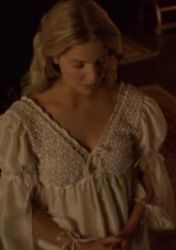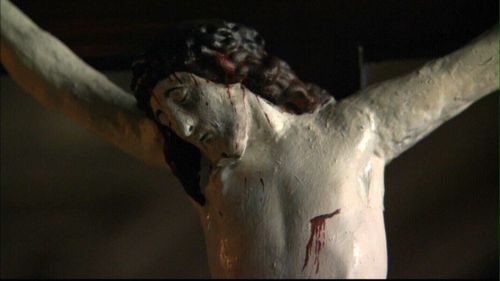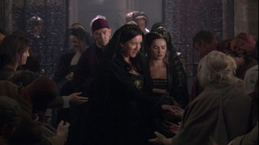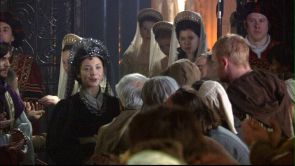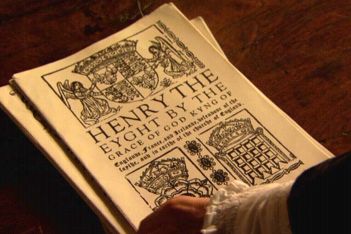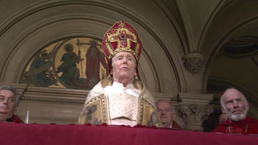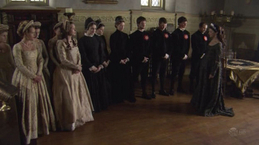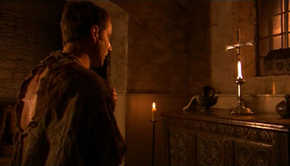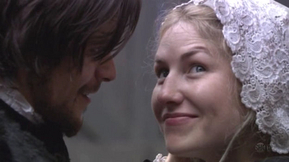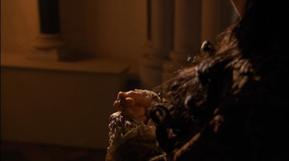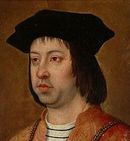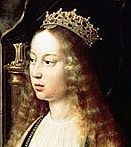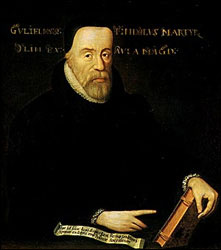RELIGION & the Tudors
Jump to navigation
Jump to search
Religion plays a very prominent role
in The Tudors series It was a battle between the Conservative Catholics & the Reformers
each convinced that their truth was the only truth 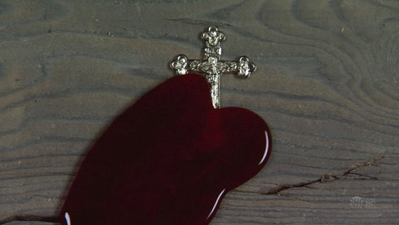
Click EasyEdit to update this page! (Don't see the EasyEdit button above? <a href="/#signin" target="_self">Sign in</a> or <a href="/accountnew" target="_self">Sign up</a>.)
See also : Reformation and The Tudor Women
Religion plays a very prominent role
in The Tudors series
in The Tudors series
It was a battle between the Conservative Catholics & the Reformers
each convinced that their truth was the only truth
each convinced that their truth was the only truth

Click EasyEdit to update this page!
(Don't see the EasyEdit button above?
<a href="/#signin" target="_self">Sign in</a> or <a href="/accountnew" target="_self">Sign up</a>.)
See also : Reformation and The Tudor Women
See also : Reformation and The Tudor Women
| King Henry & Religion |
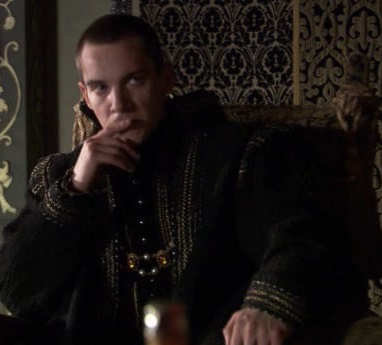 Although King Henry VIII's reformation broke with the papacy, his own religious beliefs were orthodox, and the Church of England remained essentially Catholic in doctrine under his rule. He was not concerned with religion so much as power. Although King Henry VIII's reformation broke with the papacy, his own religious beliefs were orthodox, and the Church of England remained essentially Catholic in doctrine under his rule. He was not concerned with religion so much as power. Henry VIII did not seek Protestant reform, but the abolition of papal jurisdiction inevitably encouraged the emergence of Protestant sympathizers. In 1539 Henry issued the Act of Six Articles, against those who advocated such Protestant reforms as marriage for the clergy or the denial of the doctrine of transubstantiation. On July 30th, 1540, Henry had 6 men executed. 3 reformers were burnt for heresy Under the Six Articles of faith & 3 catholics for denying royal supremacy. For Henry, it was about Power....the power to do what he wanted. To dissolve his marriage to his first Wife and legitimize his son by another wife. Since he had issues with a daughter succeeding him. Ironically, he would have two daughters who succeeded him. See also : <a class="external" href="http://www.youtube.com/watch?v=bpkk_zNTU2c" rel="nofollow" target="_blank" title="Henry's Prayer roll from the 500th exhibition">Henry's Prayer roll from the 500th exhibition</a> |
"The term Reformation is at best a deceptive word. In England it is a singularly inaccurate description for the religious upheaval that took place when Henry's tender conscience was strained beyond endurance by the fascination of Anne Boleyn and by his failure to beget a male heir by his first wife, Katherine of Aragon. Little was reformed by the English Reformation under Henry VIII, but much was transferred; the temporal authority of the Pope in Rome was assumed by the King in London; much of the spiritual power claimed by the vicar of Christ was shouldered by God's anointed lieutenant on earth; and the monastic lands were turned over to a national aristocracy. As one disillusioned and embittered Lutheran complained: Harry only wants to sit as Antichrist in the temple of God, and that Harry should be Pope, The rich treasures, the rich incomes of the Church, these are the Gospel According to Harry. The Reformation in England was never the work of a single will. The seizure of the ecclesiastical machinery in England, the denial of papal supremacy, and the destruction of an independent clerical organization were in a sense the culmination of the main currents of English and Western European history. The eighth Henry achieved what the second had failed to do the subjugation of an international priestly order that recognized an authority beyond and above that of the national monarch. The Pope was a foreigner living in dissolute luxury in Rome, and Englishmen had for centuries resented the jurisdiction and financial extractions of an alien potentate. The Tudor sovereigns were dedicated to the destruction of any supremacy outside their own, and as the feudal magnates of the northern shires ended their lives upon the scaffold, so did those abbots and bishops who acknowledged a law higher than that of the Crown. They died upon the altar of the sovereign national state that recognizes no power on earth except its own" ~ Lacey Baldwin Smith in A Tudor Tragedy |
<embed allowfullscreen="true" height="340" src="http://widget.wetpaintserv.us/wiki/thetudorswiki/widget/youtubevideo/89d429df958b5866fdae27862041166396b9c76d" type="application/x-shockwave-flash" width="560" wmode="transparent"/> Experts consider the 'thorny issue of religious belief in Henry VIIIs England'. [sources: <a class="external" href="http://www.youtube.com/user/HistoricRoyalPalaces" rel="nofollow" target="_blank">HistoricRoyalPalaces</a> May 22, 2009] |
| "The English Reformation was not merely a religious event; it was also a social one. While the spiritual mould of the Middle Ages was shattered, a corresponding revolution, no less complete and no less far-reaching, occured in the structure of secular life and the seat of power. The Knights and ecclesiastics who had ruled for ages vanished away, and their place was taken by a new class of persons, neither chivalrous nor holy, into whose competent and vigorous hands the reins, and the sweets, of government were gathered..." Lytton Strachey |
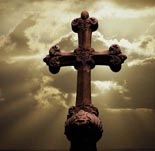 Conservative Catholics stood for the old order with celibate priests disseminating the word of God & the scriptures being in Latin. Never questioning Papal authority. | 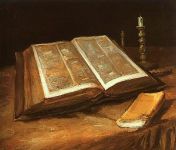 Evangelical Reformers a movement for change led by Luther & Tyndale to have the bible translated into English for the common folk to read and questioned the church for its corruption and excesses. |
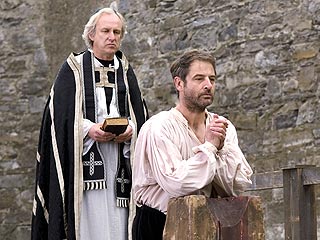 Sir Thomas More (Season 2 Episode 5) Catholics consider him to be a saint ...others that he was the last medieval man who would not countenance change. Thomas was a strict Catholic and did what he believed the Bible and God asked of him. Thomas would not accept the King as Head of the Church on Earth and was executed for his beliefs on July 6th, 1535. It is believed by some that Thomas repented of his harsh view on reformers before his death in a letter written to his daughter Margaret More where he said he wished no harm on anyone. He was made a Saint by Pope Pius XI in 1935. See also : Sir Thomas More Controversies | 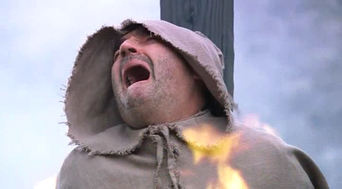 Simon Fish (Season 1 Episode 10) who was arrested on charges of heresy but died in 1531 of bubonic plague in prison before his trial. In November of 1531 a book peddler was burned named Richard Bayfield, whose death was similar to the fictional one of Fish portrayed in The Tudors (he prayed in English while burning). The series was correct to state that Thomas More had *6 people burned (but Fish was not one of them) for heresy during his Chancellorship and also had 40 others imprisoned. *Along with Bayfield, there was also Thomas Hitten (1530), Thomas Bilney (1531), John Frith, John Tewkesbury, John Bainham & William Tyndale . [source: Moynahan, God's Bestseller] |
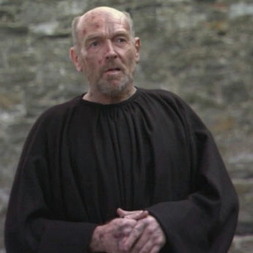 Bishop John Fisher (Season 2 episode 5) was Queen Katherine of Aragon's Confessor and her only champion and advocate. He appeared on her behalf before the legates at Blackfriars; and wrote a treatise against the divorce that was widely read. He was arrested & brought to Trial. The charge was that he did "openly declare in English that the king, our sovereign lord, is not supreme head on earth of the Church of England," and was condemned to a traitor's death at Tyburn, a sentence afterwards changed. 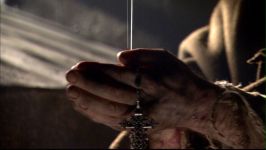 He was beheaded on Tower Hill on the 22nd of June 1535 & was the only one of the English bishops that dared to resist the king's will. Like More, Fisher was also canonized by Pope Pius XI in 1935 and they share the same feast day - June 22nd. | 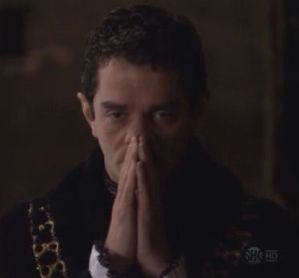 (Seasons 1 - 3) Thomas Cromwell, Earl of Essex who had reformist leanings but allied himself with the catholic faction to oust the Boleyns who were reformers. He was however, the architect of the Dissolution of the Monasteries. In 1540, he was charged with selling export licenses illegally, granting passports and commissions without royal knowledge. Most significantly, however, he was charged with heresy - this charge was the bulk of his attainder. Sir Thomas Howard, 3rd Duke of Norfolk , allied with the Catholic bishops Cromwell had forced from power, engineered this charge. *In the series, Charles Brandon, 1st Duke of Suffolk fulfills this role unlike history. Cromwell, they charged, had encouraged and spread heretical literature, allowed heretics to preach, released them from prison, and allied himself against their enemies. Significantly, it was reported that in March 1539 Cromwell said that, even if Henry turned from Protestantism, 'yet I would not turn, and if the king did turn, and all his people, I would fight in this field in mine own person, with my sword in my hand against him and all other'. That was treason. |
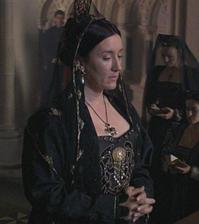 (Season 1) Queen Katherine of Aragon was an extremely devout Catholic. It was because of her strong beliefs that she never relented to Henry during their divorce trial and during her exile. Her love and devotion to God kept her strong during her final years. It was Katherine's faith in God that allowed her to forgive Henry of all of his misdeeds against her. | 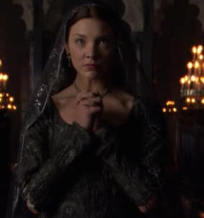 (Season 2) Anne Boleyn was very supportive & even defended the censored writing of Protestant upstarts BUT worshipped as a Catholic until her death. She was known to possess several illegal books including those authored by William Tyndale, Simon Fish, Francis Denham, as well as several Bibles translated in French and English. As queen, she encouraged members of her household to read Tyndale's translation of the Bible for their spiritual well being. |
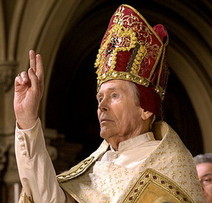 (Season 2) Pope Paul III during his papacy he became a fierce proponent of the Counter-Reformation. In 1540 he allowed the creation of the Jesuit Order, who would help Christianize the New World. He is known for passing a papal bull forbidding the enslavement of Native Americans so that they could be converted to Catholicism. Two years later, he opened the Roman Inquisition in an effort to keep Protestants out of Italy (it would last until the mid nineteenth century). He also convened the Council of Trent in 1545 which would solidify Church dogma. | 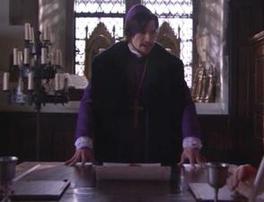 (Season 2) Thomas Cranmer most famous for having decided the validity for King Henry VIII's marriage to Anne Boleyn in 1533 (and later determining it invalid in 1536). He wrote the first two editions of The Book of Common Prayer (the liturgy of the Church of England) and The Thirty Nine Articles (defined Anglican doctrine). He was Archbishop of Canterbury until he was disgraced from office and later burned at the stake during the Marian persecutions. |
Jane Seymour (Seasons 2 & 3) had been a lady in waiting to both previous queens but her allegiance lay with Katherine of Aragon and the catholic faith. Even speaking out in favour of the catholic men involved in the uprising of the Pilgrimage of the Grace. To which Henry reprimanded her to quit meddling in affairs of state. She was also instrumental in returning Princess Mary Tudor to court under the urging of the Catholic Faction and Ambassador Chapuys. 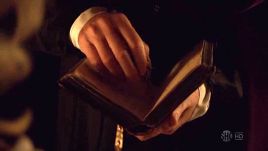 Ironically, after her death, her brother Edward Seymour would propel England even further into the protestant cause while acting as Lord Protector during Henry's son Edward's reign. | 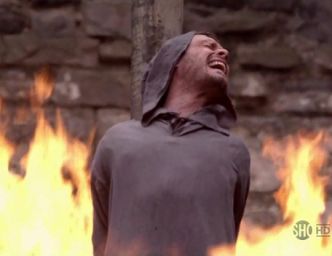 John Lambert (Season 3 episode 6) His death marks a turning point in the early process of the English Reformation and with this man's blood King Henry VIII etched his warning against doctrinal liberality. John Lambert had picked a theological dispute with a pastor in London. He didn’t buy into transubstantiation, the Catholic doctrine (still extant today) that the bread blessed on the altar became the literal body of Christ. Though the Church of England would ditch this belief soon thereafter, it came down hard on Lambert in a show trial attended by Thomas Cromwell and Thomas Cranmer. The king himself debated theology with the accused, though mostly he left it to his august councilors. A few months later, Henry induced Parliament to pass the <a class="external" href="http://www.tudorplace.com.ar/Documents/act_six_articles.htm" rel="nofollow" target="_blank">Act of the Six Articles</a>, essentially establishing this essentially Catholic doctrine as the basis for the Church of England and criminalizing dissent. Many historians see this as a product of the shifting balance between reformers and conservatives advising the crown. |
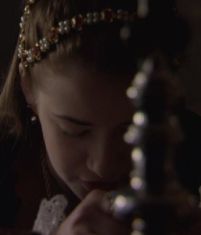 Princess Mary Tudor (Seasons 1 - 4) Just as strongly devout a catholic as her mother, she became the figurehead for the Catholic Faction after her mother's death | 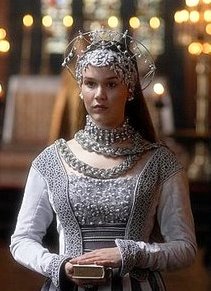 Anne of Cleves who is seen as furthering the aims of the reformation in the series although she did remain a catholic all her life. Her sister was married to the head of The Schmalkaldic League (an alliance of Protestant Territories) and Thomas Cromwell had seen the union as another stepping stone to the reformation.(Season 3) |
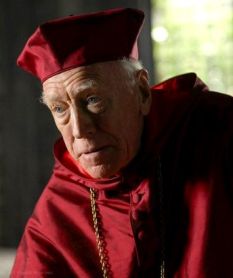 Cardinal Von Waldburg (Season 3) | 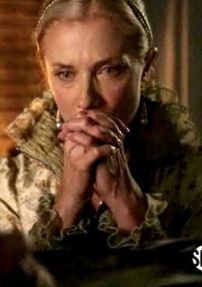 Catherine Parr (Season 4) |
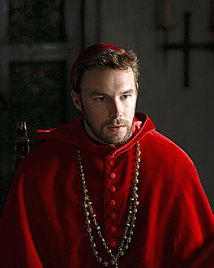 Cardinal Reginald Pole & the Pole Family (Season 3) 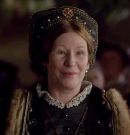 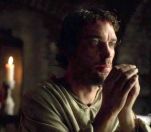 Lady Salisbury & her son Henry Pole Cardinal Pole was ready to assist the leaders of the Pilgrimage of the Grace in overthrowing the King and stepping into his shoes. However, instead, his family were executed and the rebellion was crushed. | 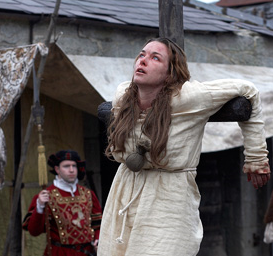 Anne Askew (Season 4) History records that Anne was probably a friend and some time companion of the Queen, Catherine Parr. Anne was known for circulating the Bible and other religious books, along with tracts in the palace and around the king’s courtyard. While traveling to London, Anne was taken prisoner by a group of priests who were following her. One of the charges brought against her was her rejection of the Catholic mass. She was accused of holding to "the new learning" ie.Heresy. While in prison Anne was subjected to all kinds of torture in order to make her incriminate herself and confess the names of others, particularly the Queen and her entourage at court, who believed like she did but she told them nothing. |
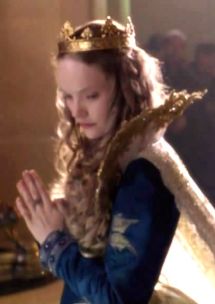 Katherine Howard was the unlikely figurehead for the Catholic Faction which was led by her uncle Thomas Howard, 3rd Duke of Norfolk 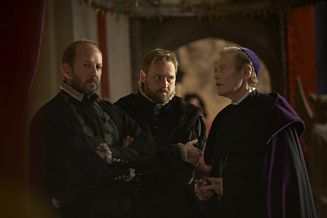 Risley, Richard Rich & Bishop Gardiner Represent the "old" guard who took every opportunity to route out what they saw as Heresy from reformers. | 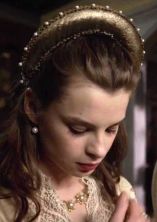 Catherine Brandon Historically Catherine was an active reformer in Catherine Parr's circle but this is not shown in the series. 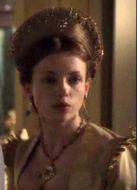 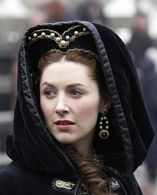 Anne Parr , Lady Herbert & Anne Stanhope ,Lady Hertford All the above ladies were part of Queen Catherine Parr's inner circle, and they were all evangelical reformers. After Anne Askew was arrested, under the pain of torture; warrants for the arrest of the Parr sisters and the other ladies were sent out. Bishop Stephen Gardiner and his new ally Wriothesley (Risley)obtained Henry's agreement to a coup against the Queen. Her leading women, Ladies Herbert, Lane and Tyrwhitt, would be arrested; their illegal books seized as evidence; and the Queen herself sent 'by barge' to the Tower. Catherine Parr, however, warned of what awaited her, apologized to Henry. Quickly reconciled, and when Wriothesley (Risley) arrived with forty yeomen of the guard at his back with an arrest warrant for the Queen , was greeted with a barrage of real abuse from the King and sent packing with his tail between his legs. and |
| CATHOLICS | REFORMERS |
| Alms-giving Alms-giving is considered a dominical (from the mouth of Jesus) command that faithful Christian s should give to (in old English) the "most nedfull poore people." Reformers, such as John Frith, called into practice such "obligatory" giving, and went as far to call it a sin to do good works just to gain favor with God. | 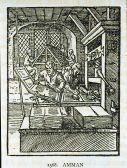 Reformist literature Reformist literatureAlthough not technically a religious practice, in season 2 episode 6, Thomas Cromwell shows George Boleyn a printing press as a "new invention" to spread the word by means of pamphlets etc. The printing press was an important part of the reformer movement, it pointed out the corruption & excess of the Catholic Church to the common man. It is doubtful the movement would have spread as it did, without it. |
| Services and Scripture in Latin In episode 2.6, Pope Paul III addresses the crowd by offering a prayer in Latin. Supporters of keeping the Bible in Latin (like Thomas More) argued that the common man did not have the theological training to interpret the Bible and needed priests to decipher the meanings for them, or else they may be led astray. | Scripture translated in English In episode 2.3, Anne Boleyn instructs her household to read from Tyndale's English translation of the Bible. A major tenant of the Protestant Reformation called for both church services and scripture to be in the language of the common people, as opposed to Latin. The first English language Bible actually authorized by the Church of England and King Henry VIII was The Great Bible, also called "Cromwell's Bible," in 1538. |
| Mortification of the Flesh - meaning to "put the flesh to death" or to earthly desires. This was done by different means from self denial to chastising your body by self flagellation, wearing hair shirts & chains. Thomas More is known to have done this, as was shown in the series. Flagellation was not an uncommon practice by fervently religious Catholics. Being a flagellant was a form of penance (an act to receive forgiveness) that involved whipping oneself in order to show ones piety. | Marriage by the Clergy was a major reformist tenant after the precedent set by German monk Martin Luther's marriage to Katharina von Bora. In season 2, Archbishop Thomas Cranmer smuggles his "illegal wife" to England from Germany in a wooden crate. In his book "Thomas Cranmer: A Life" Historian Diarmaid MacCulloch raises, only to dismiss, the rumour that she was kept in a box. however he does say that Margaret, the second Mrs. Cranmer, must have lived in England so secretly that even her husband's most bitter opponents never learned of her existence. Perhaps the box was used as symbolic of that fact? |
| Rosary Beads are used to keep track of the number of Hail Mary said. Along with Hail Mary, the beads are used when the user meditates on Mysteries of The Rosary, which are about Jesus Christ and his mother Mary. |
| *See also "The Reformation Gallery" |
<embed allowfullscreen="true" height="344" src="http://widget.wetpaintserv.us/wiki/thetudorswiki/widget/youtubevideo/f4d38ed9f6d8c62fc15e4ce6cd8dfca7c996a3e4" type="application/x-shockwave-flash" width="425" wmode="transparent"/> |
| In History - By Definition, Martyrs are imitating Christ whether Catholic or Protestant Reformers |
| Ferdinand II of Aragon & Isabella I of Castille [parents of Queen Katherine of Aragon] established the Spanish Inquisition in 1478 allowing them to intervene directly in religious affairs. An Inquisition had previously existed in Spain but only under papal control. The Inquisition was a Catholic ecclesiastical tribunal that had jurisdiction only over baptised Christians. It therefore mainly worked to ensure the orthodoxy of recent converts such as conversos (converted Jews) and moriscos (converted Muslims). Various motives have been proposed for the monarchs' decision to found the Inquisition, such as increasing political authority, weakening opposition, doing away with conversos, and as a way to fund the re-conquest of Granada. It is also thought that they wished to unite Spain under Roman Catholicism. The Inquisition had the power to arrest, hold, torture and execute people, it is thought that up to 2,000 people were executed with most activity occurring between 1480 and 1530. The Inquisition did not begin to focus on Protestants until after the accession of Charles I in 1516. It was not until 1834 that the Inquisition was officially abolished. For many years, Isabella has been supported as a candidate for sainthood for her promotion of Christianity to the New World. A case the beautification in 1974 was halted due to complaints by Jewish organizations. In 1992, King Juan Carlos issued an official apology to the Sephardic Jewish community for their persecution and issued them special immigration rights. | William Tyndale "Father of the English Bible" - His translation was the precursor of the King James Bible. He was described by Thomas More as"a hell-hound of the kennel of the devil who discharged blasphemies of his brutish, bestely mouth." Due to a network of spies & informants paid by either King Henry VIII, Thomas More, or John Stokesley, Bishop of London, Tyndale was arrested & tried for heresy in 1535. It is not cetain who paid Henry Phillips, who betrayed Tyndale to authorities, but John Stokesley is often suspected. Thomas More was imprisoned and without a royal pension when Phillips arrived in Antwerp. Thomas Cromwell did try to intercede on his behalf but in 1536 he was tied to a stake, strangled & his body burnt. His reported last words were : "Lord, open the King of England's eyes," [source: William Tyndale, a biography by David Daniell source: History of Our English Bible by Ronald D. Lesley] |
 In 1539, When Glastonbury Abbey was the last Abbey standing, Thomas Cromwell who was now Vicar General sent his 3 "inquisitors", Commissioners Layton, Moyle and Pollard to the Abbey. Without enquiry, without defence, without a judgement Abbot Richard Whiting & two of his monks, John Thorne and Roger James, were dragged on a hurdle through the streets of Glastonbury, in front of the empty Abbey, up to the Tor for execution.They were hanged, disemboweled, beheaded and quartered. The Abbot's head was stuck on a spike above his abbey gateway for all to see. | <a class="external" href="http://en.wikipedia.org/wiki/Image:Thomas_Bilney.jpg" rel="nofollow" target="_blank" title="Thomas Bilney.jpg"> Thomas Bilney was an English preacher born in Norwich around 1495. He was trained as an academic, but was inspired after reading Erasmus's Greek translation of the New Testament and dedicated the rest of his life to studying scripture and preaching to people in the field even when he was no longer welcome by the catholic church. Although he held true to many of the old beliefs, he was strongly opposed to saint and relic veneration, and could not accept the mediation of saints. He was also a firm believer that Jesus alone was responsible for saving people from sin. After being imprisoned in the Tower of London on heresy charges for over a year in 1527, he was released only to be imprisoned again, tried, and sentenced to burn at the stake. He was executed at Lollards Pit in Norwich on August 19, 1531. 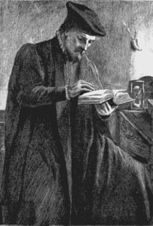 </a> </a> |
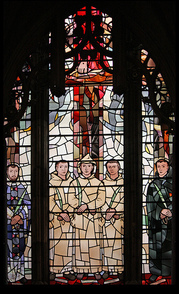 The Carthusian Martyrs Between 1535 to 1537, a total of 18 monks from the Charter House in London were hanged for failing to recognize the King as head of the Church of England. The only brother who survived was Brother William Horne, however he was eventually executed in 1540 for refusing to surrender his religious habit. Pope Leo XIII beatified the 18 in 1886 and three of the monks were canonized by Pope Paul VI in 1970. | 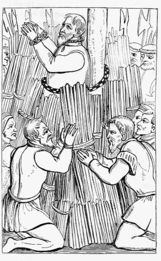 John Frith was the author of many reformist writings in response to the works of high profile catholics such as Thomas More, Bishop Fisher, and John Rastell. As a student at Oxford University, he was imprisoned for harboring "heretical texts." He spent much of his adult life in continental Europe, condemning the beliefs of transubstantiation and purgatory. He eventually was arrested upon his return to England on the order of Chancellor Thomas More and was burned at the stake July 4, 1533 after refusing an offer of pardon that depended on him renouncing his previous stances. |
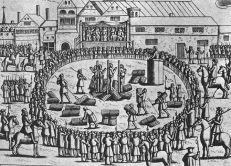 Anne Askew Anne Askew |
CLICK LINKS FOR MORE INFO:
| BOOKS:
|
